Mississippi’s Tanglefoot Trail
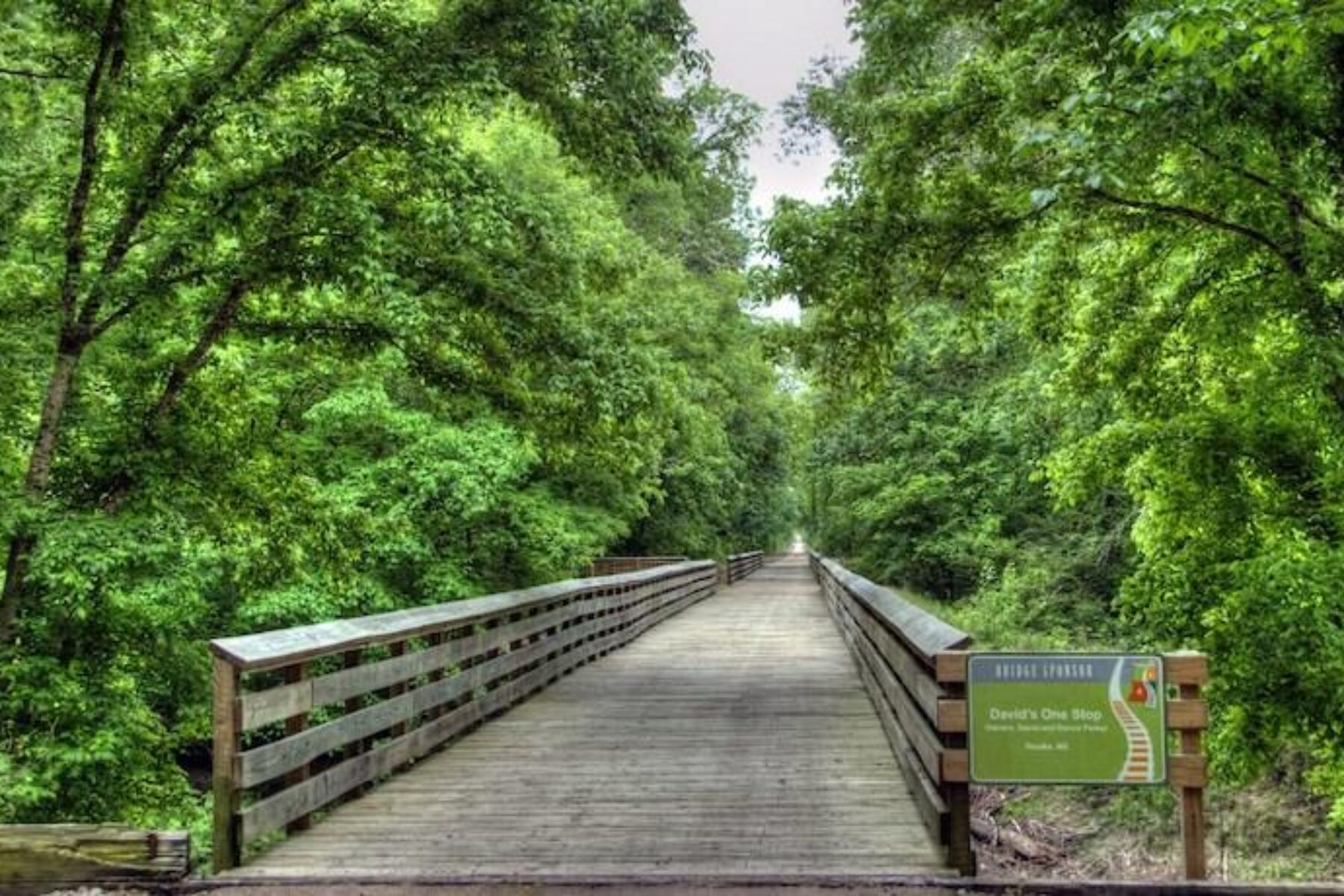
Trail of the Month: August 2019
“We’re seeing people from all over the place, including other countries, who would never have heard of us had it not been for the trail.“
—Bob McGee, a local bicyclist
Something new came to northeast Mississippi in 2013, winding through a handful of sleepy towns nestled into the bucolic foothills of the Appalachian Mountains and awakening a new sense of community pride. All 43.6 miles of the Tanglefoot Trail opened at once, becoming the longest rail-trail in the state, and connecting these communities together like never before.
Hesitation and skepticism about the new pathway lingered in some residents’ minds at first, but just six years later, the local passion for the trail is undeniable. This Southern gem, journeying through picturesque countryside and pastures with horse and cattle, was ushered into the Rail-Trail Hall of Fame this summer, capturing more than half of the 26,000+ public votes that made this year’s national Hall of Fame contest the biggest one to date.
A New Way of Life
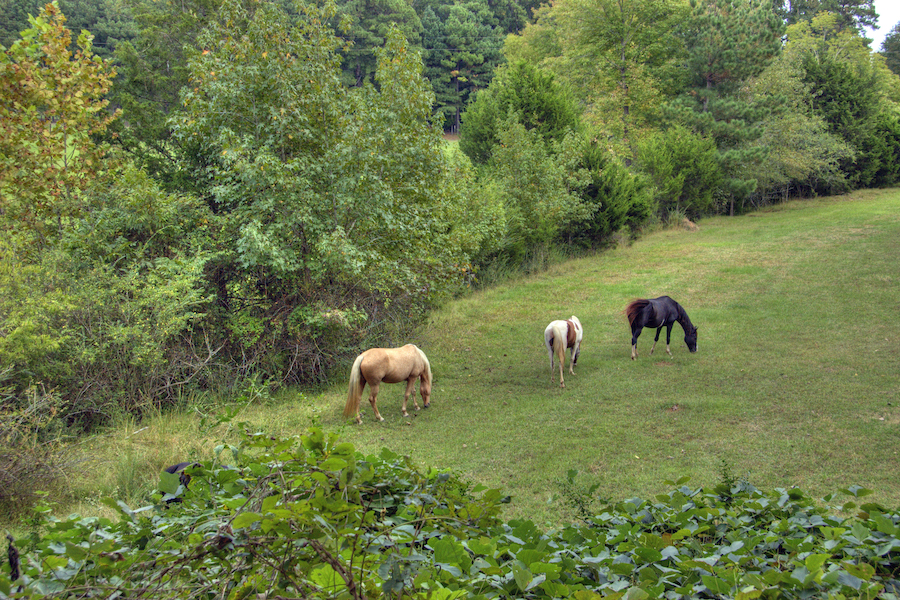
“Pontotoc was an ideal place to grow up, a small town like you see pictured in movies,” said Bob McGee, a local bicyclist who rides the Tanglefoot several times a week. “When I first heard about the trail project, I thought, ‘Never in a million years will that happen in North Mississippi.’ But now, we’re seeing people from all over the place, including other countries, who would never have heard of us had it not been for the trail.”
The trail is managed by the Three Rivers Planning and Development District; Randy Kelley, its executive director, admits that the Tanglefoot has surpassed his expectations. “I was lukewarm about it initially, but what turned it around for me was how many people use it,” said Kelley. “I never thought the utilization would even approach what it is.”
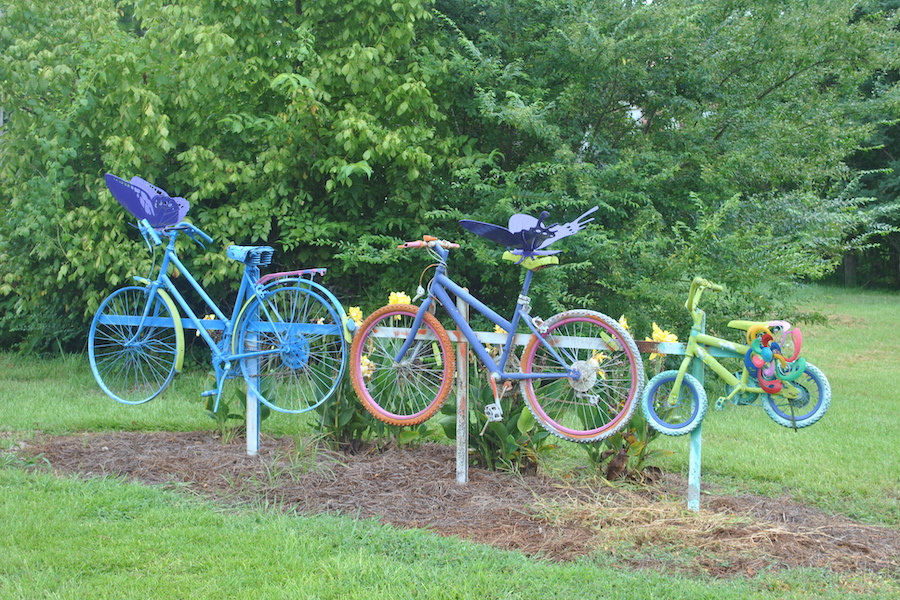
Six rural communities lie along the paved pathway—some with just a few hundred people—stretching from New Albany to Houston, Mississippi, and each has a seat at the table on the trail’s governing board. It’s telling that, sprinkled throughout these communities, travelers will find whimsical bicycle sculptures and even a welcoming arch made of dozens of bicycles, as well as businesses that have incorporated cycling motifs into the products they sell or into their display windows. And the trail brings together families and friends for community events throughout the year, including the Tour de Bodock ride, whose net proceeds will be donated toward the Tanglefoot’s ongoing maintenance. For these towns, the bicycle has become a symbol of a positive new way of life.
A Noble History
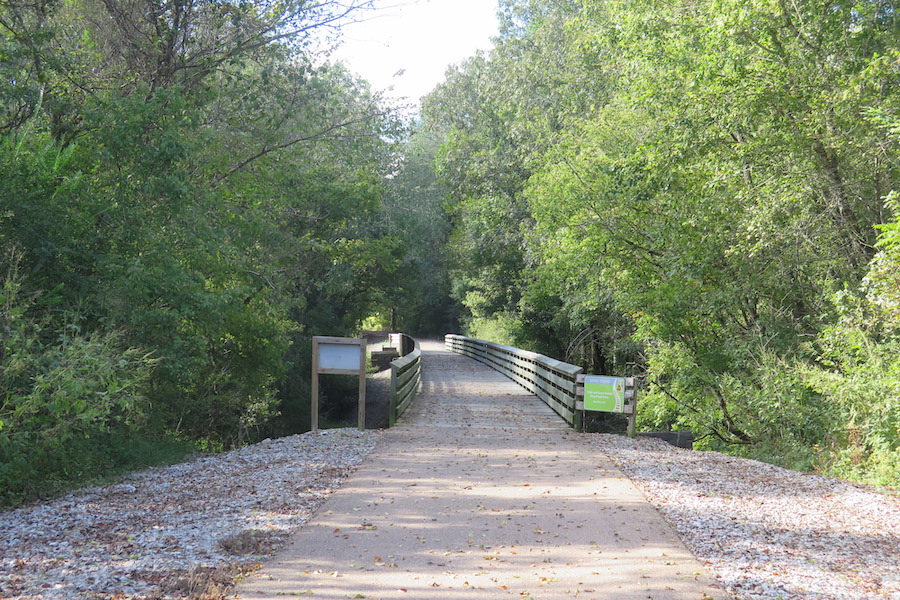
The Tanglefoot, named after a train engine, traverses the corridor of a railroad line once led by Col. William C. Falkner—the great-grandfather of Nobel-Prize-winning writer William Faulkner—in the late 1800s. The famed author was born in New Albany and spent most of his life in northern Mississippi, which heavily influenced his writing. Before the railroad, the route was used by the Chickasaw tribe and called the “King’s Highway” in honor of the last Chickasaw king, Ishtehotopah. For those intrigued by the region’s history, a museum in New Albany and another in Pontotoc, both just blocks from the trail, give glimpses into the area’s past.
“When the local railroad that came through here decided it was not profitable for them to use it anymore and was entertaining the option to sell off parcels of the railroad, a grassroots group got together and decided we wanted to maintain the railbed,” said Bob Peeples, Pontotoc’s mayor, about the trail’s early days. “We went through the railbanking program to keep it intact and turned it into a rails-to-trails project, which has become a phenomenal thing for us.”
Best of Both Worlds
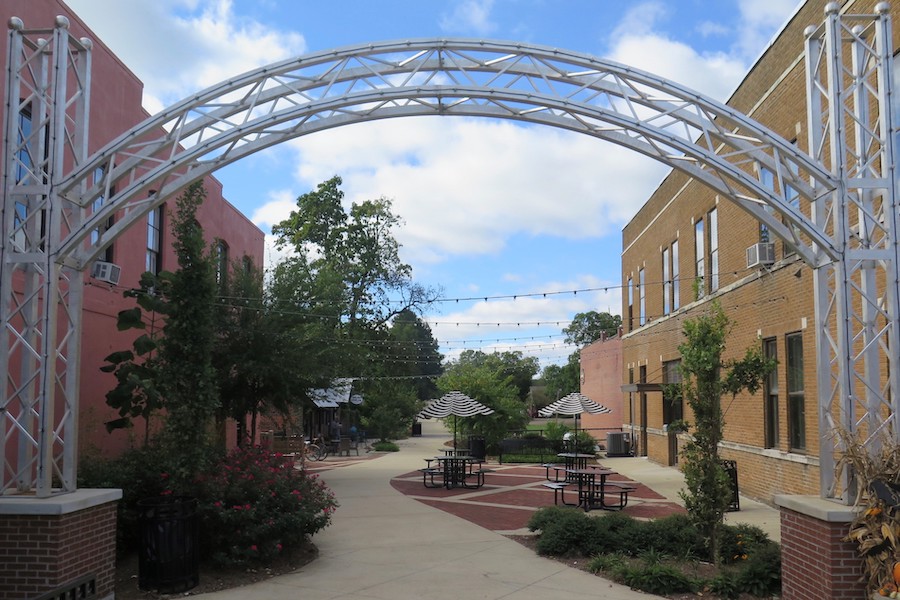
Since the trail opened, trail advocates have not rested on their laurels. Improvements for the trail—and with it, a revitalization of community projects, like parks, too—have continued to roll out. In the three largest towns along the route, trailhead and gateway facilities serve as busy gathering places with tourist information centers, retail shops, restaurants and other services. Since the trail’s arrival, more than a dozen new businesses have also opened their doors.
“The towns grew up around the railroad, so the trail goes right through the middle of most of them, and you’re able to get the flavor of the different towns along the way,” said Peeples, who enjoys weekly walks on the trail. “There are also the rural areas where you’ll see lots of wildlife, so you get the best of both worlds.”
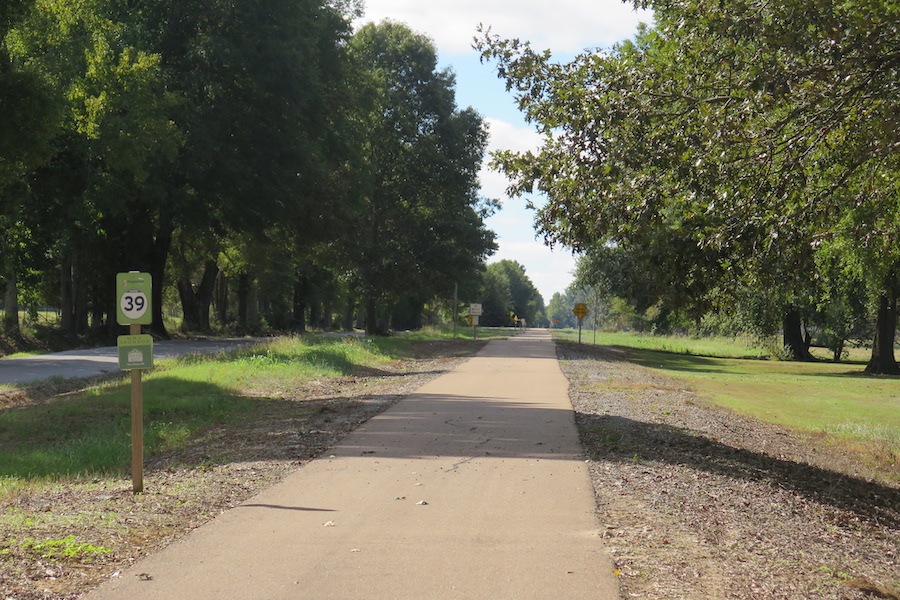
It’s in the quiet spaces between the towns that the Tanglefoot’s natural beauty really shines. “It’s tree lined for probably 75 percent of the trail, so you’re riding under the branches, which really cools it down in the summer; it feels like air conditioning coming through there,” said Ray Collins, board chairman for the GM&O Rails-to-Trails District. “And in the fall, there are lots of sweetgum trees that turn red and yellow and purple; they’re beautiful.”
In the more sparsely populated areas of Ingomar, Ecru, Algoma and New Houlka, four “whistle stops,” designed to be reminiscent of railroad stations, ensure that trail users have the amenities they need—including restrooms, drinking water and picnic tables—every few miles. A handful of trailside self-service fix-it stations are also available for on-the-fly bicycle repairs.
A Diverse Team
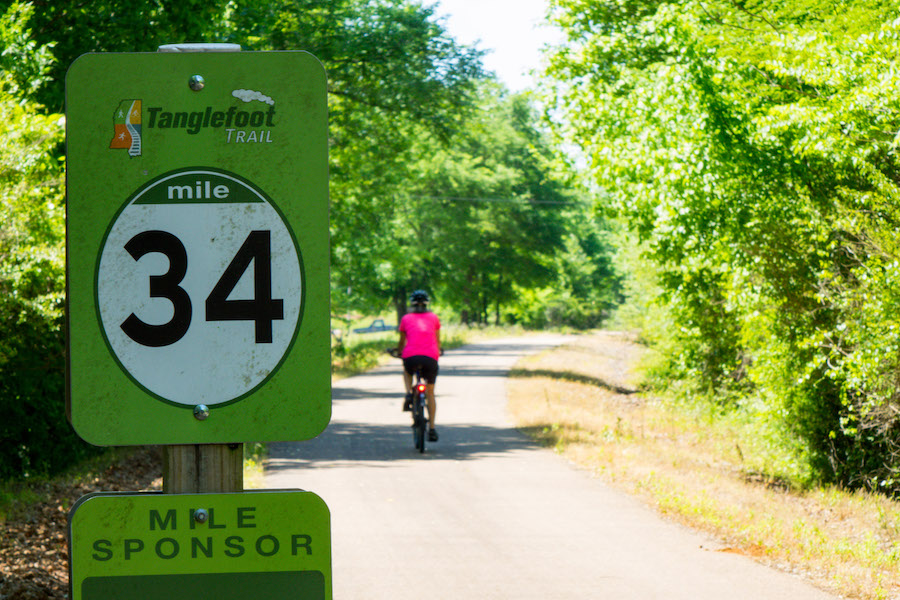
Collins credits the thoughtfulness surrounding the trail user experience to “a lot of brainstorming” resulting from having such a diverse trail board comprising people from all walks of life. Their different perspectives have contributed to a wellspring of enhancements for pathway.
Supporting these efforts are local businesses—nearly 100 of them, running the gamut from restaurants, bike shops, banks and grocery stores—that have signed up for sponsorships to help finance trail projects, such as bridge work and trailside amenities. Lee Nabors, a sponsor who owns a lumber business in Houston, said it “just made sense” to take part in the community effort and notes that he hasn’t heard one negative comment about the trail since it opened.
“It’s unbelievable how it’s become part of my life; I can get off work, go ride 20 miles on the trail and be back in time to watch the late evening news and cook a steak on my grill. It’s pretty neat,” enthused Nabors who, like many locals, has fully embraced the trail and rides it often.
“A lot of people put a lot of hard work into making the trail come to fruition,” said Peeples. “It’s a very high honor to be inducted into the Hall of Fame, and we’ll do everything we can to make sure we stay worthy.”
Related: Mississippi’s Tanglefoot Trail Inducted into Rail-Trail Hall of Fame
Related Links
- GM&O Rails-to-Trails Recreational District
- Three Rivers Planning and Development District
- Rail-Trail Hall of Fame
Trail Facts
Name: Tanglefoot Trail
Used railroad corridor: Gulf, Mobile and Ohio Railroad
Trail website: GM&O Rails-to-Trails Recreational District
Length: 43.6 miles
County: Chickasaw, Pontotoc, Union
Start point/end point: The rail-trail runs from Daniel Boone Street and W. Church Street in Houston (mile marker 0) north to W. Bankhead Street and N. Railroad Avenue in New Albany.
Surface type: Asphalt
Uses: Walking, bicycling and inline skating; wheelchair accessible
Difficulty: Easy; the trail is entirely paved with the level grade typical of most rail-trails.
Getting there: The closest major airport to the trail is the Memphis International Airport, 70 miles northwest of New Albany. Tupelo Regional Airport also serves the trail area.
Access and parking: Parking is available at the three trailhead/gateway facilities in the largest communities along the route (one at each end of the trail and one in the middle):
- Houston (583 West Church St.; milepost 0)
- Pontotoc (121 South College St.; milepost 25.1)
- New Albany (Carter Avenue; milepost 43.6)
The trail also has four “whistle stop” facilities that provide parking, restrooms, water fountains, bike racks and picnic tables:
- New Houlka (205 West Front St.; milepost 9.9)
- Algoma (24 Weeks St.; milepost 19.3)
- Ecru (279 South Railroad Ave.; milepost 32.6)
- Ingomar (1103 County Road 90; milepost 37.1)
To navigate the area with an interactive GIS map, and to see more photos, user reviews and ratings, plus loads of other trip-planning information, visit RTC’s free trail-finder website, TrailLink.com
Rentals: A handful of bike shops are listed on the Tanglefoot Trail website. Your closest option is about 15 miles away at Trails and Treads (549-B Coley Road, Tupelo; 662.690.6620).

Donate
Everyone deserves access to safe ways to walk, bike, and be active outdoors.
